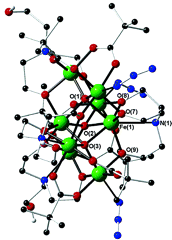Abstract of Publication No. 567
 Ayuk M. Ako, Oliver Waldmann, Valeriu Mereacre, Frederik Klöwer,
Ian J. Hewitt, Christopher E. Anson, Hans U. Güdel and Annie K. Powell
Ayuk M. Ako, Oliver Waldmann, Valeriu Mereacre, Frederik Klöwer,
Ian J. Hewitt, Christopher E. Anson, Hans U. Güdel and Annie K. Powell
Odd-Numbered FeIII Complexes: Synthesis, Molecular Structure,
Reactivity, and Magnetic Properties
Inorg. Chem. 46, 756-766 (2007)
![]()
![]()
![]()
![]()
Abstract:
A field-dependent inelastic neutron scattering (INS) experiment on an
array of oriented single crystals of Mn12-acetate is reported.
The experimental results provide clear evidence that the minority
species observed in the INS spectra is the fast-relaxing species
observed in, for instance, AC-susceptibility measurements.
Three isostructural disklike heptanuclear FeIII compounds of the
general formula
[FeIII7(m3-O)3(L)3(m-O2CCMe3)6(h1-O2CCMe3)3(H2O)3],
where L represents a di- or triethanolamine moiety, display a three-blade
propeller topology, with the central Fe atom representing the axle or axis of
the propeller. This motif corresponds to the theoretical model of a frustrated
Heisenberg star, which is one of the very few solvable models in the area of
frustrated quantum-spin systems and can, furthermore, be converted to an
octanuclear cage for the case where L is triethanolamine to give
[FeIII8(m4O)3(m4-tea)(teaH)3(O2CCMe3)6(N3)3]·1/2MeCN·1/2H2O
or [FeIII8(m4O)3(m4-tea)(teaH)3(O2CCMe3)6(SCN)3]·2MeCN
when treated with excess NaN3 or NH4SCN, respectively. The
core structure is formally derived from that of the heptanuclear compounds by
the replacement of the three aqua ligands by an {Fe(tea)} moiety, so that the
3-fold axis of the propeller is now defined by two central FeIII
atoms. Magnetic studies on two of the heptanulcear compounds established
unequivocally S = 5/2 spin ground state for these
complexes, consistent with overall antiferromagnetic interactions between the
constituent FeIII ions.